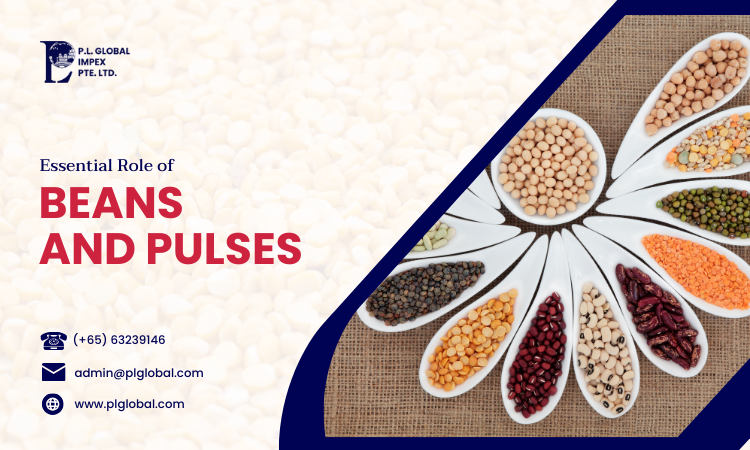Table of Contents
Introduction:
Making sure that everyone has access to wholesome food is essential in a society where environmental issues and population growth are major concerns. Pulses, or beans, are a broad family of legumes that prove to be formidable partners in this battle. The potential contribution of pulses and beans to world nutrition is examined in this (blog). We’ll examine their importance as environmentally friendly and potentially self-sufficient food sources, emphasizing their ability to feed a burgeoning global population. Prepare to learn about the power of these small yet formidable legumes!
1. How Beans and Pulses Can Revolutionize Global Protein Needs:
Though everyone needs access to enough high-quality protein, it can be difficult to ensure that this essential building block for our bodies is available to all. Concerns about ethics and the environment are frequently associated with animal-based sources of protein. A revolution in the field of global protein demands occurs with the introduction of pulses and beans.
Combining these humble legumes with grains provides a complete (amino acid) profile and loads of protein. In other words, they supply every vital component our bodies require to operate as intended. As a more ethical and ecological source of protein, beans, and pulses require a lot less land and water to produce than meat.
Another revolutionary feature of pulses and beans is their affordability. In contrast to animal protein, they are more affordable, making them available to a wider range of financial situations. For everyone to have a nutritious diet and to achieve global food security, this is imperative.
Beyond only being high in protein, beans, and pulses have an amazing nutritional profile. Fiber, vitamins, and minerals abound in them, promoting general health and wellness. They are a globally appreciated nutritional staple because of their adaptability in the kitchen, which inspires inventive and delectable meal preparations.
Global nutrition can be revolutionized by adopting pulses and beans as the main source of protein. To fulfill the increasing demands of a populace for protein, they provide a cost-effective, ethical, and ecological alternative. To create a better and more sustainable future for everybody, let’s harness the potential of these little nutritious powerhouses.
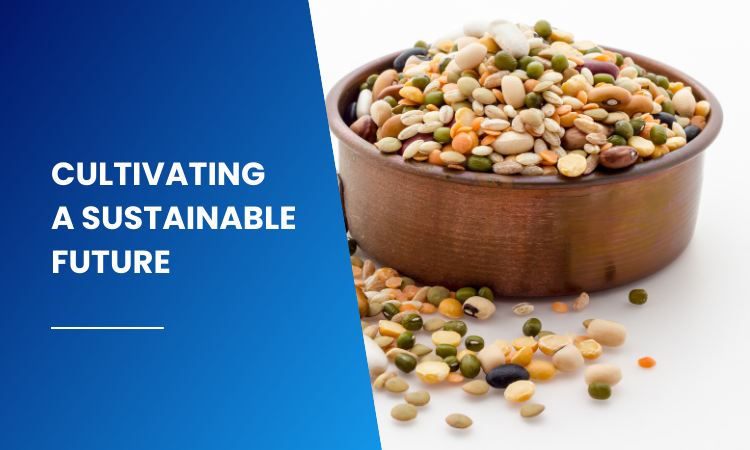
2. Cultivating a Sustainable Future: Why Beans and Pulses are the Key to Food Security:
Securing food security for a world population that is expanding becomes an increasingly urgent challenge as we look to the future. At this point, pulses and beans enter the picture and provide a potent remedy. Cultivating a more secure and sustainable food system is largely dependent on these simple beans.
Producing beans and pulses uses a lot less water and area than animal agriculture, which uses a lot of resources. Sustainable agricultural practices can benefit greatly from their ability to flourish in a variety of climates and even enhance soil fertility. Reduced environmental impact is a result, which is important for halting climate change and guaranteeing sustained food production.
Another notable drought resistance is exhibited by pulses and beans. Since water shortage is becoming a bigger problem in many parts of the world, this trait makes them a dependable source of sustenance in those areas. Moreover, the extended shelf life of these products reduces food waste, which is a major cause of worldwide food insecurity.
Another essential component is the cost of beans and pulses. People with minimal finances can get them because they offer an affordable source of critical nutrients, especially protein. All economic levels are encouraged to adopt healthy eating habits and food security by this affordability.
Our future selves can be cultivated with everyone having access to healthy, safe food by incorporating pulses and beans into our food systems. Widespread acceptance is aided by their culinary adaptability, which produces a variety of mouthwatering entrees.
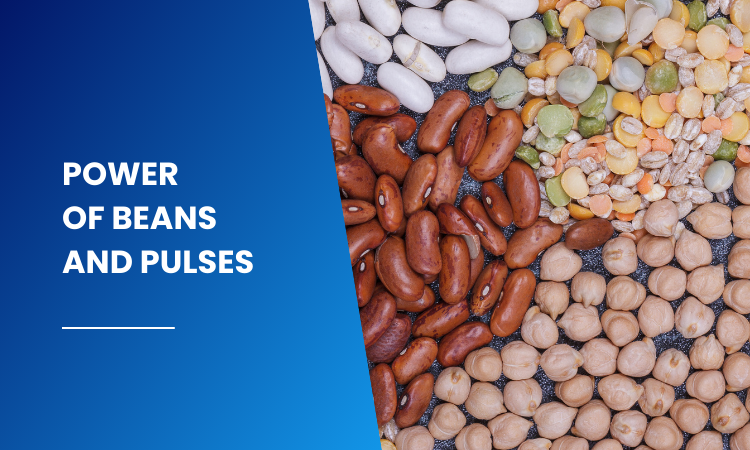
3. Eating Ethically, Eating Smart: The Power of Beans and Pulses for a Healthier Planet:
In the modern world, ethical consumers are searching for more and more ways to choose foods that are good for the environment and themselves. In this context, beans and pulses stand out as winners because they provide a potent means of promoting ethical and informed eating.
Animal agriculture undoubtedly has an impact on the environment. Cattle farming uses a lot of water and land, which frequently results in resource depletion and deforestation. Conversely, beans and pulses fix nitrogen in the soil, allowing them to grow with very little and even improving soil health. You can eat delectable meals with a clear conscience because of the much reduced environmental impact that results from this.
Conscious consumerism is also influenced by ethical worries about animal welfare. You automatically lessen your reliance on industrial farming practices when you include pulses and beans in your diet. Combining these legumes with cereals provides a comprehensive protein source that eliminates the need for animal-based protein and the moral conundrums that come with it.
Pulses and beans are wise and moral choices, and their health benefits only serve to reinforce this. Rich in fiber, protein, vitamins, and minerals, they are a nutritional powerhouse. This results in better heart health, digestion, and general well-being. Healthy eating is also made pleasurable by their adaptability, which enables the preparation of tasty and inventive dishes.
4. A World of Flavor, a World of Nutrition: Exploring the Culinary Versatility of Beans and Pulses:
Though sometimes regarded as a lowly side dish, pulses and beans should take center stage in your kitchen. Along with having an amazing health profile, these nutrient powerhouses also have a surprisingly deep flavor and versatile cooking range. Together, we will travel the world to discover the delectable world of pulses and beans.
Beans and pulses are staples in cuisines all across the world, from the creamy comfort of Indian dals to the smokey depth of Mexican frijoles. They take up the flavors of herbs and spices quickly, which makes them quite versatile in a variety of cooking techniques. While delicate adzuki beans become the sweet center of anko paste for red bean desserts in Japan, chickpeas are transformed into colorful falafel fritters in the Mediterranean.
The variety of textures found in beans and pulses broadens their culinary application. Mashed white beans provide a creamy base for spreads and dips, and lentils give body to soups and stews. Kidney beans give a meaty texture to chili while black beans give a pleasing bite to salads. Your dinners will always be tasty and interesting thanks to this range, which guarantees that every dish has the ideal pulse.
Beyond being versatile, pulses and beans provide an unfinished canvas for imaginative culinary experimentation. To realize their full potential, try a variety of spices, herbs, and cooking techniques. Make a colorful black bean burger, combine kidney beans into a rich and creamy chocolate mousse, or roast chickpeas for a crunchy snack. The options are unlimited.
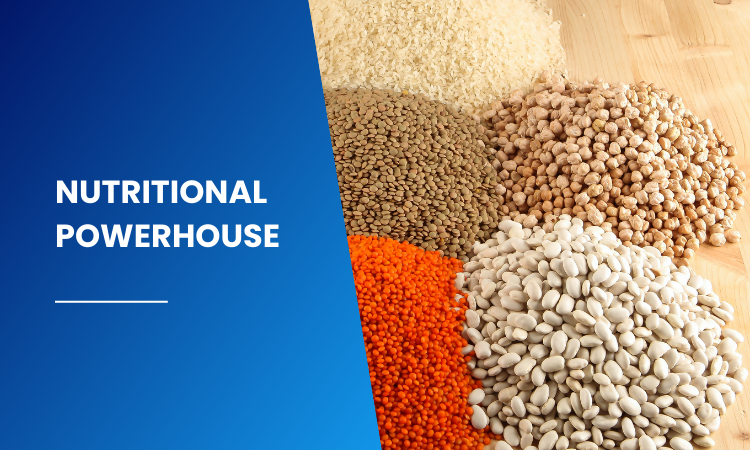
5. The Humble Bean: A Nutritional Powerhouse for Every Culture:
Their modest appearance does not deceive you. The lowly bean, a member of the legume family that also includes peas, chickpeas, and lentils, is a nutrient-dense superfood that has been a staple on dishes for generations. These little miracles are a mainstay of many countries’ culinary traditions because they contain the key to unlocking a world of flavor and amazing health benefits.
Pulses and beans have an outstanding nutritional profile. When paired with cereals, they provide all the key amino acids required by our bodies for optimal performance, making them a complete protein supply. Additionally, they are a great source of fiber, which promotes better digestion and prolongs feelings of fullness. They also support general health and well-being because they are a great source of vitamins, minerals, and antioxidants.
Beans and pulses are a staple in cuisines all throughout the world, demonstrating their diversity. In Asia, they serve as the foundation for filling curries and dals. Their creamy richness is celebrated in Latin American refried beans and dips, while European cuisine uses them in stews and soups. Beans and pulses are used in a wide variety of culinary traditions, from the Middle Eastern falafel to the Japanese edamame, each with its own distinct flavor.
People from all socioeconomic situations can benefit from these small nutritious powerhouses because of their cost. Encouraging everyone to eat healthily and attaining global food security depends heavily on this. They are much more significant because of their sustainable manufacture. When compared to (animal husbandry), beans and pulses require a lot less land and water, so choosing them is both ethical and environmentally beneficial.
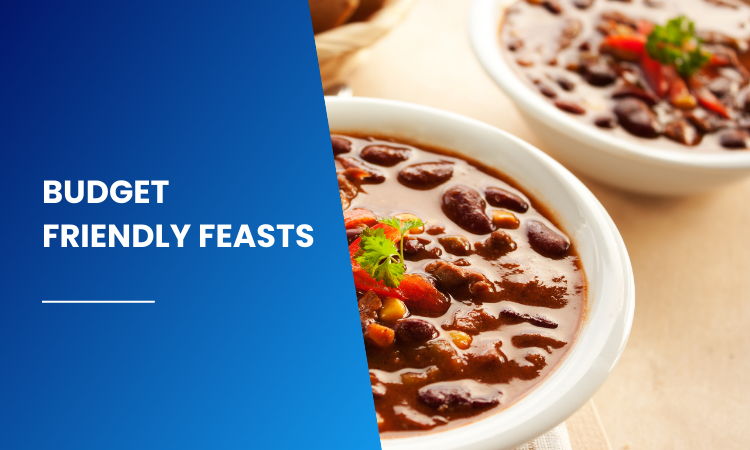
6. Budget-Friendly Feasts: Delicious and Affordable Meals with Beans and Pulses:
Tight budget? Not a problem! To the rescue, beans, and pulses provide an abundance of tasty and reasonably priced meals that won’t break the wallet. These adaptable legumes are a filling and healthy foundation for a wide variety of recipes because they are high in protein and fiber. Prepare to go on a gourmet journey without breaking the bank.
The affordability of beans and pulses is what makes them so beautiful. They are far less expensive than sources of animal protein, so you can spend less on groceries overall. They are therefore perfect for preparing filling and healthful meals for both people and families.
Beyond their low cost, beans, and pulses provide an open canvas for creative cooking. Turn them into tasty, creamy soups, stews, and dips. Make colorful, high-protein, high-fiber salads, or make delectable vegetarian tacos and burgers. There are countless options!
Let’s look at some inexpensive dinner suggestions. A satisfying and reasonably priced classic comfort meal is a potent lentil soup served with crusty bread. Another tasty and protein-rich inexpensive alternative is chickpea curry over rice. Try a colorful black bean salad with avocado and salsa for a lighter option. It’s a tasty and nutrient-dense lunch.
Pulses and beans are versatile enough for use in meals other than main courses. A delicious and reasonably priced appetizer or snack is hummus, a creamy dip made from chickpeas. Mashed white beans can be used in spreads or dips that provide wraps and sandwiches an extra protein boost. These inexpensive essentials add flair to any dish.
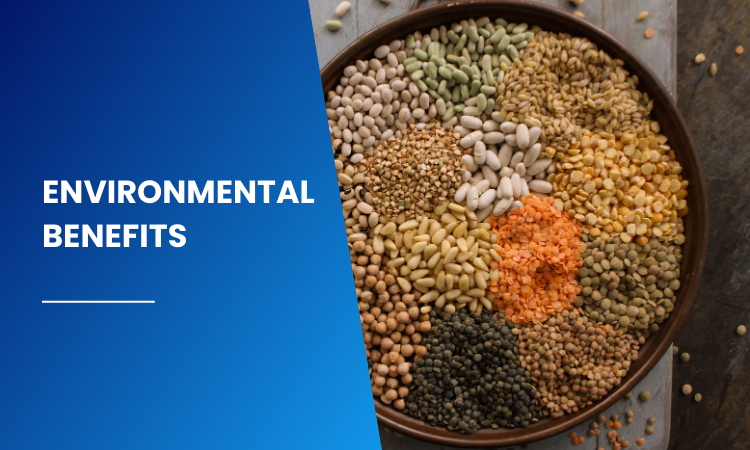
7. Cultivating Goodness: The Environmental Benefits of Beans and Pulses:
Our dietary decisions are vital in our quest for a more sustainable future. In this regard, beans and pulses come out on top since they provide a wealth of environmental advantages that should be acknowledged. Let’s explore how these lowly legumes foster a more wholesome Earth.
In contrast to livestock agriculture which uses a lot of resources, the cultivation of beans and pulses uses a lot less water and land. They grow well in a variety of climes and even improve soil quality by (fixing nitrogen) in the soil. This results in lessening the impact on the environment by reducing soil deterioration, water depletion, and deforestation. You are actively promoting sustainable farming practices by selecting beans and pulses.
Another benefit of beans and pulses for the environment is their remarkable resistance to drought. These hardy crops are able to thrive in areas where water scarcity is a rising problem worldwide. This guarantees a dependable supply of nourishment and protein even in difficult settings.
In addition, pulses and beans have a lower carbon footprint than animal husbandry. The production of livestock has a major impact on greenhouse gas emissions. You may actively lessen the effects of climate change and your carbon footprint by increasing the amount of beans and pulses in your diet.
The advantages go beyond lowering greenhouse gas emissions and conserving resources. Beans and pulses contribute to a healthy agricultural ecosystem by improving soil structure and suppressing weeds. As a result, less hazardous chemical pesticides and fertilizers are required, therefore reducing environmental pollution.
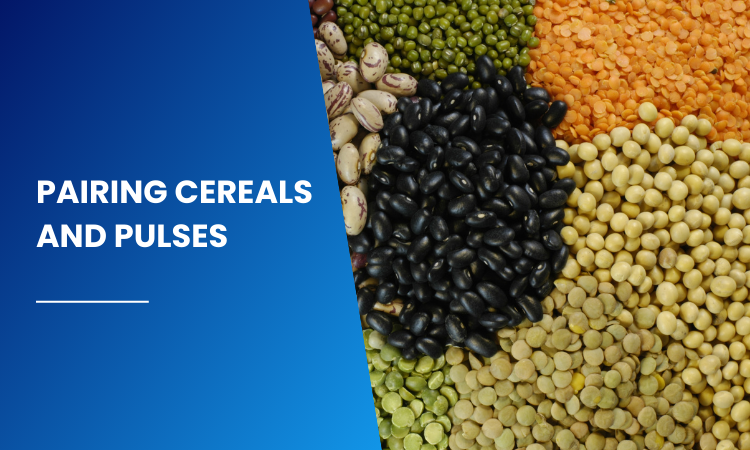
8. The Perfect Partnership: Pairing Cereals and Pulses for Complete Protein:
Although protein is an essential component of our bodies, it can be difficult to make sure we obtain all the necessary amino acids from our diet. Here comes the dynamic combo of pulses and cereals—a match made in heaven that unleashes the full power of protein!
While grains like rice and wheat as well as beans and pulses like lentils, chickpeas, and others are good sources of protein, none of them alone provides the entire range of required amino acids. They make an ideal nutritional team, though, when matched carefully.
The secret is in the lysine content of beans and pulses; cereals are usually lacking in this important amino acid. On the other hand, methionine, another vital amino acid that cereals have in large amounts, is frequently absent from beans and pulses. Your body receives a full protein source when these two food categories are combined into one meal, meeting all of its protein requirements.
There are many advantages to this ideal alliance. In areas where animal protein may be expensive or rare, it’s an economical and sustainable way to increase protein intake. Compared to animal agriculture, the cultivation of cereals and pulses usually requires less water and area, making them more affordable.
With this dynamic pair, the culinary options are virtually limitless. Consider robust lentil soups served with whole-grain bread, traditional rice and bean dishes from around the world, or even high-protein breakfast bowls made with quinoa and chickpeas.
9. A Bean for Every Season: Discover the Diverse World of Beans and Pulses:
Beyond pantry staples, beans, and pulses are a vibrant and diversified family that provides a taste and nutritional experience for every season. These tiny legumes add diversity and excitement to your meal all year long, from the lush chickpeas of summer salads to the robust lentils’ warming winter soups.
Vibrant and fresh flavors are perfect for spring. Combine (feta cheese), asparagus, and green lentils in a simple salad. Edamame, the young soybean pod, is deliciously steamed and seasoned with sea salt. It’s also a great addition to stir-fries.
Grilling and lighter cuisine are perfect during the summer months. Protein- and fiber-rich black bean burgers are a tasty and healthful substitute for regular beef burgers. Vibrant chili bowls made with kidney beans are the ideal light summertime meal.
The cozy warmth of stews and soups takes center stage as fall approaches. Tasty lentil stews paired with root vegetables are ideal for chilly autumn nights. Pumpkin curries are a seasonal treat enhanced by the creamy texture and protein-dense content of chickpeas.
Winter calls for filling, substantial meals. Chili that is deep and savory, with kidney beans taking center stage, will warm you from the inside out. For a vegetable- and protein-rich winter minestrone soup, white beans make a creamy base.
Beyond its adaptability to different seasons, the varied universe of pulses and beans offers a worldwide culinary experience. Discover the subtle sweetness of adzuki beans in Japanese delicacies, the silky texture of chickpeas in Middle Eastern creamy hummus, and the earthy richness of black beans in Mexican cuisine.
10. The Future of Food is Here: Why Beans and Pulses are Leading the Sustainable Food Movement:
People all over the world want to live in a future where food security and environmental health go hand in hand. Beans and pulses are the unsuspecting heroes of this quest. They are leading the way in the drive for sustainable food. Let us look at why these simple legumes are the key to a safer and healthier food system.
Raising animals uses a lot of resources, growing beans and pulses only needs a small amount of land and water. They do well in a wide range of climates and even improve the health of the land by fixing nitrogen. This translates to a significantly reduced environmental footprint, making them a sustainable and responsible food choice.
The amazing ability of beans and pulses to survive in dry conditions also makes them a reliable food source in places with little water, which is becoming a bigger problem for our world. Therefore, food security is maintained even when weather conditions are tough.
An important part of the sustainable food movement is the stress of ethical sourcing. Compared to animal farming, growing beans, and grains usually needs less pesticides and fertilizers. Their plant-based nature also fits with the growing ethical worries about the welfare of animals in factory farms.
In addition to being leaders in the fight for sustainable food, beans, and pulses are also very cheap. People of all wage levels can afford them and get the nutrients they need, like protein. Globally, this improves food security and encourages good eating habits.
In the future, the tasty and adaptable nature of beans and pulses will be very important for their broad use. Integrating them easily into different types of food makes it possible to make creative and filling meals, which makes eating sustainably fun for everyone.
Conclusion:
In the struggle for adequate nutrition for all people, beans, and pulses have become indispensable allies. They are essential for a healthy future because of their prolific output, low cost, and high nutritional profile. Embracing these adaptable legumes and investigating their potential to contribute to a more secure and sustainable food system is important as we work to feed an expanding population. We are grateful that you could come along and learn about the vital role that pulses and beans play in world nutrition.


